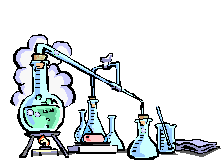Physical, Chemical, and Nuclear Change:
A physical change
is reversible by physical means.
- the solution process -- one substance is dissolved in
another substance. Example: salt dissolved
in water -- if the water evaporates, the salt is left unchanged.
- a phase change -- in which a substance goes from one
phase to another; solid, liquid, or gas, by the addition or removal of
heat. Example: ice (solid water) melts to
liquid water -- if the temperature of the liquid is lowered, the ice is
restored.
A chemical change -- a
substance undergoes a reaction in which the products have different properties
than the reactants. Example: silver nitrate
reacts with sodium chloride to produce silver chloride and sodium nitrate.
A nuclear change --
involves changes in nuclear structure, such as fission (splitting) of a nucleus
or an atom, or fusion (combining) of neutrons and protons to form heavier
atoms. This involves about 1,000,000 times as much energy as a chemical
change.

Last modified
Contact us for more info

|

|
